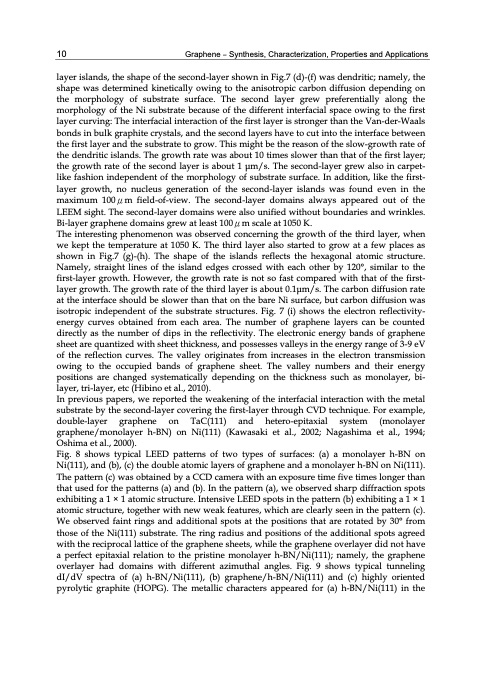
PDF Publication Title:
Text from PDF Page: 020
10 Graphene – Synthesis, Characterization, Properties and Applications layer islands, the shape of the second-layer shown in Fig.7 (d)-(f) was dendritic; namely, the shape was determined kinetically owing to the anisotropic carbon diffusion depending on the morphology of substrate surface. The second layer grew preferentially along the morphology of the Ni substrate because of the different interfacial space owing to the first layer curving: The interfacial interaction of the first layer is stronger than the Van-der-Waals bonds in bulk graphite crystals, and the second layers have to cut into the interface between the first layer and the substrate to grow. This might be the reason of the slow-growth rate of the dendritic islands. The growth rate was about 10 times slower than that of the first layer; the growth rate of the second layer is about 1 μm/s. The second-layer grew also in carpet- like fashion independent of the morphology of substrate surface. In addition, like the first- layer growth, no nucleus generation of the second-layer islands was found even in the maximum 100μm field-of-view. The second-layer domains always appeared out of the LEEM sight. The second-layer domains were also unified without boundaries and wrinkles. Bi-layer graphene domains grew at least 100μm scale at 1050 K. The interesting phenomenon was observed concerning the growth of the third layer, when we kept the temperature at 1050 K. The third layer also started to grow at a few places as shown in Fig.7 (g)-(h). The shape of the islands reflects the hexagonal atomic structure. Namely, straight lines of the island edges crossed with each other by 120°, similar to the first-layer growth. However, the growth rate is not so fast compared with that of the first- layer growth. The growth rate of the third layer is about 0.1μm/s. The carbon diffusion rate at the interface should be slower than that on the bare Ni surface, but carbon diffusion was isotropic independent of the substrate structures. Fig. 7 (i) shows the electron reflectivity- energy curves obtained from each area. The number of graphene layers can be counted directly as the number of dips in the reflectivity. The electronic energy bands of graphene sheet are quantized with sheet thickness, and possesses valleys in the energy range of 3-9 eV of the reflection curves. The valley originates from increases in the electron transmission owing to the occupied bands of graphene sheet. The valley numbers and their energy positions are changed systematically depending on the thickness such as monolayer, bi- layer, tri-layer, etc (Hibino et al., 2010). In previous papers, we reported the weakening of the interfacial interaction with the metal substrate by the second-layer covering the first-layer through CVD technique. For example, double-layer graphene on TaC(111) and hetero-epitaxial system (monolayer graphene/monolayer h-BN) on Ni(111) (Kawasaki et al., 2002; Nagashima et al., 1994; Oshima et al., 2000). Fig. 8 shows typical LEED patterns of two types of surfaces: (a) a monolayer h-BN on Ni(111), and (b), (c) the double atomic layers of graphene and a monolayer h-BN on Ni(111). The pattern (c) was obtained by a CCD camera with an exposure time five times longer than that used for the patterns (a) and (b). In the pattern (a), we observed sharp diffraction spots exhibiting a 1 × 1 atomic structure. Intensive LEED spots in the pattern (b) exhibiting a 1 × 1 atomic structure, together with new weak features, which are clearly seen in the pattern (c). We observed faint rings and additional spots at the positions that are rotated by 30° from those of the Ni(111) substrate. The ring radius and positions of the additional spots agreed with the reciprocal lattice of the graphene sheets, while the graphene overlayer did not have a perfect epitaxial relation to the pristine monolayer h-BN/Ni(111); namely, the graphene overlayer had domains with different azimuthal angles. Fig. 9 shows typical tunneling dI/dV spectra of (a) h-BN/Ni(111), (b) graphene/h-BN/Ni(111) and (c) highly oriented pyrolytic graphite (HOPG). The metallic characters appeared for (a) h-BN/Ni(111) in thePDF Image | GRAPHENE SYNTHESIS CHARACTERIZATION PROPERTIES

PDF Search Title:
GRAPHENE SYNTHESIS CHARACTERIZATION PROPERTIESOriginal File Name Searched:
Graphene-Synthesis.pdfDIY PDF Search: Google It | Yahoo | Bing
Salgenx Redox Flow Battery Technology: Power up your energy storage game with Salgenx Salt Water Battery. With its advanced technology, the flow battery provides reliable, scalable, and sustainable energy storage for utility-scale projects. Upgrade to a Salgenx flow battery today and take control of your energy future.
| CONTACT TEL: 608-238-6001 Email: greg@infinityturbine.com | RSS | AMP |